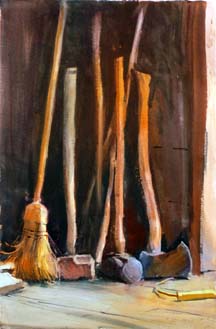|
|
Timothy
J. Clark
at Hammer Galleries
(Photos courtesy of Hammer Galleries)
By
RAYMOND J. STEINER
ART TIMES March 2009
PAINTERS
WHO HAVE tried their hand at representational art in the medium of watercolor
know that it takes more than the will to succeed…much, much more. First
and foremost the accomplished watercolorist needs a sure hand, since each
stroke of the brush is not only telling but permanently “on record” for
all to see, each misstep a glaring distraction from the motif and/or effect
desired. In short, it takes the confidence of a mature draftsman, one
with a seasoned eye for light and form, a sure sense of composition, a
sensibility that is trained in the use of colors and how they work one
against (or for) the other, a fluidity of brushstroke, and lastly, an
innate instinct for just what makes a ‘good’ picture. The 30+ paintings
in this solo exhibition at the Hammer Galleries* certainly reveals Timothy
J. Clark as firmly in charge of all of the intricacies of this most demanding
of mediums…without doubt, Clarke’s “Sense of Solace” reflects the craft
of a master watercolorist.
 Vermazza 1994 watercolor on paper |
It
ought to be noted that there were several oils in the show — “McSorley’s
Bar”, “Serenity”, and the charming little study, “Studio Sink” —
but, for this viewer, it was the watercolors that consistently drew me
onward through the several galleries that housed the show. If the two
paintings displayed in Hammer’s front windows — “The Bicycle” and
“San Carlos al Corso Crepuscular” — offered a ‘sneak preview’ of
the range of motifs that lie in store for the viewer inside, a large watercolor
hanging on the right wall as you entered set the stage for the complexity
of Clark’s overall aesthetic vision. “Study for My Garage”, a painting
of the interior of a workshop, is literally crammed from floor to ceiling
with tools, tubs, fan belts, cans, jugs, vises, machines, and whatever
flotsam and jetsam has been banned from the house (including a pin-up
hanging on the far wall), Clark’s skillful handling of color, form, and
composition never allowing this incredible hodge-podge of objects to remain
— well, a hodge-podge — but, instead, presenting them as a
finely-crafted panorama of mini-still lifes, each separate and fully-realized,
each perspectively ‘correct’, each comfortably nestled alongside its neighbor.
 Family Reunion, 2008 watercolor on paper |
Range
— from portraits of homely hand tools (among my particular favorites,
reminding me of John Carlson who, while teaching at the League’s summer
sessions during Woodstock’s heyday as an art colony, admonished his students
to skip the exotics and paint what they could find “in their backyards”),
to portraits of beautiful women in interior settings, to snatches of architecture
in foreign lands, to landscapes of exotic climes — and complexity
— as noted in his “Study for My Garage”, but evident throughout
the exhibit — are not the only hallmarks of Clark’s visually-stunning
oeuvre. He switches easily from soft- to hard-edge, from bold statement
to nuanced suggestion, from small- to large-scale, all the time subtly
modifying and muting his color (often using soft, lavender/violet tones)
in ways that invite the viewer “inside” — whether it be a living
room — “Reading” (and others); a Plaza — “Clock Tower, Venice”
(and others); a street scene — “Water Carrier Rhythms”; or a church
interior, “Serra Chapel” — or, indeed, even into his Garage with
his signature purplish wash on floor and ceiling. As if this were not
enough to challenge his resources, Clark even includes a night scene,
“Moonlit Night, Maine” ‘ but it is his deft play of light (see, for example
his skies in “Angra Rooftops and Sky”, Piazza del Popolo”, and “Clock
Tower, Venice”) that is his forte.
 The Bicycle 2008 watercolor on paper |
Were
I pushed to ‘pigeon-hole’ Clark (which is always a risky thing in critiquing
an artist), I would characterize his work as ‘Impressionistic Realism”
— though, of course, each individual viewer will come away with
his/her own conclusion. And though he can certainly put to paper the lovely
form of a woman in the intimacy of her home (“On the Sofa”), an architectural
detail (“Bernini Balcony and Angels”), or a view of a townscape (“Vernazza”),
it is when Clark tightens his focus on a hand tool, a bicycle, a tractor,
or a corner of a shed, that I feel both his power and his warmth as a
chronicler of our passing world. I applaud the perspicuity of the Hammer
Galleries in mounting this show and hope that this first solo showing
of Clark’s work in their showrooms is only the beginning of a long and
lasting relationship.
(“Timothy
J. Clark: Sense of Solace” Jan 13—Feb 7): Hammer Galleries, 33 West
57th St., NYC (212) 644-4400. hammergalleries.com. A fully-illustrated
catalogue is available (see New Art Books listing this Issue).

